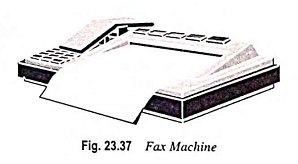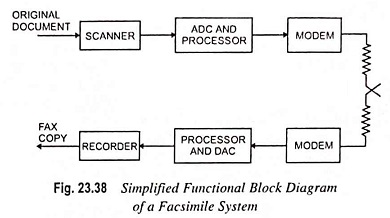Facsimile (FAX) Machine – Definition, Operation and Applications:
In addition to the basic signals consisting of speech, music, or telegraph codes, a telecommunications system is often required to transmit signals from a source of a visual nature. Facsimile (commonly called FAX) means an exact reproduction, and in facsimile transmission an exact reproduction of a document or picture is provided at the receiving end. Television means usually at a distance, and a TV system is used to reproduce any scene at the receiving end. It differs from FAX in that the scene may be “live” (i.e. including movement).
Information is transmitted at a much faster rate in TV transmission than it is in facsimile transmission. As a result, TV transmission requires a much larger bandwidth, and special wideband circuits are required. The small bandwidth required for facsimile makes it suitable for transmission over normal telephone channels.
Some of the uses of facsimile transmission are the transmission of photographs (for instance, for the press), the transmission of documents, weather maps, and so on, and the transmission of language texts for which teleprinters are not suitable so that many of the problems encountered in international operation are avoided.
Facsimile Transmitter:
A facsimile transmitter must perform several functions, as given below:
- It must dissect the source document image into a matrix of picture elements (pixels or pels) and then sense an image density and/or colour for each pixel in a sequential manner a line at a time. This process is known as the raster scanning and is similar to the one used in TV cameras.
- The signal information derived from the scan, along with scan synchronization signals, may be modulated directly onto an analog transmission channel. Alternatively, the information may be encoded for transmission on a digital data channel.
- The digital information may undergo a process of data compaction to reduce the amount of data that needs to be transmitted and thus reduce the time required for transmission. Synchronizing information is encoded as well.
- Once the encoding and compaction have occurred, the digital data may be stored in memory for transmission at a later time, or they may be transmitted without rescanning.
Facsimile Machine:
A facsimile machine is depicted in Fig. 23.37. It can send an image on a paper sheet to another fax machine over regular phone lines. Unlike the analog TV signal, fax information is sent in digital format, practical bandwidth of the system and communication channel (phone line) means that a single image takes many seconds to transmit.
However, there are similarities between a TV camera scanning a scene and the way that the paper in fax machine is scanned. A fax machine also shows how digital technology can bring benefits, since information that has been digitized can be preprocessed to achieve specific goals.
Working of a Fax Machine : The paper with the message written on it is inserted in the fax machine, where it is scanned, line by line and from top to bottom, using a special light and mirror mechanical assembly. A photocell senses the light reflected from the paper at any spot. Whenever there is a mark (writing, typing) on the paper, the photocell output voltage is very small and a binary 0 is generated, and where there is no mark the photocell output voltage is large and this generates a binary 1. The result is a series of 1s and 0s corresponding to blank areas and written areas of the single line. Each scan line is divided into 200 points per inch, so 8 1/2 inch wide paper produces 1,700 bits per line. The 1s and 0s are represented by digital IC voltages (typically TTL/CMOS values of 0 V and +5 V, nominally but they are represented by two frequency tones when sent over the phone line, within the fax machine.
At the receiving fax machine, a beam of light scan a specially treated drum surface in synchronization with the scan of the sending unit. The beam of light is turned on and off by the received is 1s and 0s and the drum turns slightly as each new line is represented. At the end of the scanned image information, the drum carries electrical charges on its surface that have complete image like a photographic negative, and then uses these charges to transfer toner ink to a piece of paper. This reproduces whatever was on the original paper (some machines use special heat-sensitive paper where a row of thermal printing dots is activated to darken the paper. This costs less but needs special paper.
Resolution : The resolution in lines per vertical inch is user selectable, with industry standard values of approximately 100, 200 and 400 lines/inch. With these numbers we see that a regular 11 inch long piece of paper has 1100 scanned lines in the lowest resolution of 100 lines/inch mode. A complete sheet therefore produces 1100 lines x 1700 bits/line = 1.87 Mbits sending this number of bits at a 2400 band rate (a standard telephone line value) will take about 779 seconds (nearly 13 minutes), which is very expensive telephone call.
Basic Facsimile Operation:
A facsimile system consists of some method of converting graphic copy on paper to an electrical equivalent signal suitable for transmission on a telephone pair (or other narrowband media), the connection of the pair/telephone circuit and transmission to the distant-end user, and the recording/printing of the copy on paper by that user. There is involvement of 8 basic functions (1 scanning, 2. A/D conversion, 3. Digital processing including compression, 4. Transmission and switching carried out by PSTN as any other telephone call, 6. Modem function (demodulation), 7. Digital processing, decompression and 8. Recording/printing).
Figure 23.38 depicts a simplified block diagram of a facsimile system showing these all eight functions. The scanning is carried out by a photoelectrical transducer, which is similar in many respects to the scanning used in video. The output of the scanner is analog, which is then converted to digital by an analog-to-digital converter (ADC). The digital signal is processed and compressed. The resulting binaries 1’s and 0’s are transmitted via a modem or other conditioning device to a standard telephone line. At the receiving end, the signal is demodulated by a companion modem, processed (which includes decompression to the original digital signal), and then digital-to-analog converted. The resulting analog signal is fed to a facsimile recorder for printing.
The complete assembly, as shown in Fig. 23.38, is incorporated directly into the facsimile equipment. The other functions of the processor are compression and operational. The operational functions include setting up of a circuit, synchronization and phasing of the transmission side with the receiving side, maintaining the circuit and finally terminating the connection when facsimile exchange is completed.
Facsimile Applications:
The facsimile machine is very useful in our daily life. By using the fax machine, we can send a paper copy of a document or picture at one place to the another place at a reasonable cost. The fax machines have the following major areas of applications :
- Personal : Personal documents like birth certificates, copies of cheques and copies of wills can be sent by facsimile when an individual get documentary evidence to a distance place in a shortest time.
- Business : The most significant use of a facsimile system is in the field of business because any document like purchase order, in voice, tender form, agreement, receipt, planning schedule or other business document can be sent to a distant place in no time.
- Law Enforcement Information : Finger prints, passport and other relevant information regarding one criminal arrested in one state can be sent by the facsimile system in very little time, to another state which needs them for investigation in another case regarding the same criminal.
- Weather : This is very important and common use of facsimile system. This system allows all the distribution of weather data collected and reduced at a central location to interested parties throughout the world.
- Libraries : Finally, the use of facsimile system in a distribution of library document from a central location to any other location throughout the world. By this means a central library can make available to the public at regional and remote places where the copies of expensive and rare original hook and documents cannot be moved.

